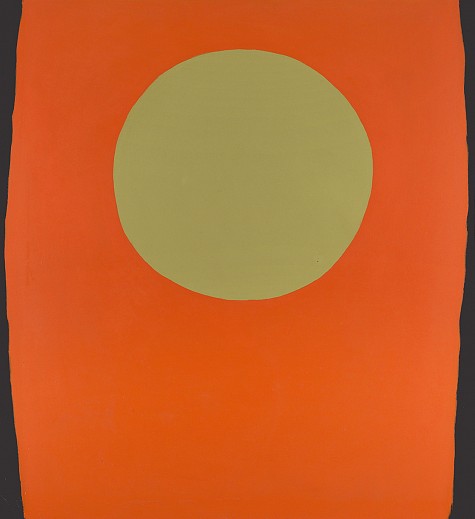
Walter Darby Bannard, Artist of the Color Field Movement, Dies at 82
October 8, 2016 - William Grimes for The New York Times
Walter Darby Bannard, a Color Field painter whose elegant, severe abstract paintings of the late 1950s and early ’60s were the springboard for a lifetime’s exploration of color, form and the physicality of paint, died on Sunday in Miami. He was 82.
The cause was complications of liver cancer, his wife, Kathleen Staples, said.
Mr. Bannard (pronounced BAN-erd), whose keen critical intelligence was reflected in his many essays on art, spent more than half a century elaborating and revising the distillation of color and form that made him an important voice in the nascent Color Field movement, sometimes called postpainterly abstraction.
Soon after graduating from Princeton, where he found common cause with the painter Frank Stella and the critic Michael Fried, he experimented with swirling, turbulent paintings, using new materials like alkyd resin, before arriving at a refined minimalism that confronted viewers with an isolated, luminous geometric form — usually a disc or a square — hovering over a single-color ground.
“Something was staring right back at you like it was another person,” he told the online magazine Artcritical last year. “That idea just fascinated me. I thought, this is the best way to present color — make it into a painting, but just barely.”
The critic Clement Greenberg included him in the pivotal show “Post Painterly Abstraction” at the Los Angeles County Museum in 1964, and the Museum of Modern Art showed his work the following year in “The Responsive Eye.” Mr. Bannard was on his way.
Over the years, he ventured into new territory, dissolving the geometry of his early painting, loosening the brushwork and complicating his surfaces with polymers and gels that lent a topographic quality to his work; it often suggested a strange landscape seen from a great height.
In every phase, Mr. Bannard showed a subtle color sense all his own, and a knack for deploying his forms in a slightly unnerving way, keeping viewers captivated and off-balance.
Walter Darby Bannard, usually called by his middle name, was born on Sept. 23, 1934, in New Haven. His father, Homes, was a railroad manager who moved the family often from one assignment to the next, to New Jersey and, during World War II, to Washington. His mother, Janet Darby, was a homemaker.
His taste for modernism surfaced early. At 11 he noticed, in the color section of a Sunday newspaper, a clown painting and a reproduction of a painting by the British abstractionist Ben Nicholson, with the question “Which kind of art do you like?” He voted for Nicholson, the butt of the joke.
“I said to myself, well, I sure know what I like,” he told Artcritical. “In fact I’m going to cut it out and put it in my wallet.”
After graduating from Phillips Exeter Academy, Mr. Bannard enrolled in Princeton, where he earned a bachelor’s degree in philosophy in 1956. At college he became absorbed in painting and soon began experimenting in the manner of Mark Rothko and Clyfford Still. An exhibition by the American abstract painter Barnett Newman suggested to him that his urge to focus on a simple, central image was correct. “That told me that I had permission to do what I was doing,” he told Artcritical.
He had his first solo show at the Tibor de Nagy Gallery in 1965. In 1973 the Baltimore Museum of Art organized a retrospective exhibition that traveled to the High Museum of Art in Atlanta and the Museum of Fine Arts in Houston.
Like many of his Color Field contemporaries, Mr. Bannard embraced new mediums that allowed him to expand his visual vocabulary. First came alkyd resins, then acrylics, applied with rollers and rags. Later he adopted tinted gels and polymers, which he applied with squeegees and, in the “brush and cut” series he began in the late 1980s, commercial floor brooms. He began thinking of color, he said in a 1990 catalog essay, “as a liquid, flowing over and settling on a roughened surface, changing as it mixed and dried.”
As a critic and commentator, Mr. Bannard wrote frequently for Art in America, Art International and other publications. In 1976 he organized and wrote the catalog for a retrospective of the work of Hans Hofmann at the Hirshhorn Museum and Sculpture garden in Washington.
In 1989 he became chairman of the art department at the University of Miami.
Mr. Bannard’s first two marriages ended in divorce. In addition to his wife, Kathleen, he is survived by two sons, William and Trevor; a brother, Robert; and a sister, Elizabeth Snookey.
After a period of neglect, Mr. Bannard began attracting renewed attention in the last decade when the Berry Campbell Gallery presented shows of his earlier work. “These colors are still radiant,” the critic Phyllis Tuchman wrote in Artforum, reviewing work from the late 1950s and early 1960s exhibited last year. “And the artist’s pale palette is as uniquely personal today as it was fifty years ago. You can’t even apply a name to his hues.”
The critic and art historian Barbara Rose organized an exhibition of his work as part of “Painting after Postmodernism: Belgium-U.S.A.,” which opened in September in Brussels. An exhibition of his recent paintings is scheduled to open at Berry Campbell on Oct 13.
Back to News
